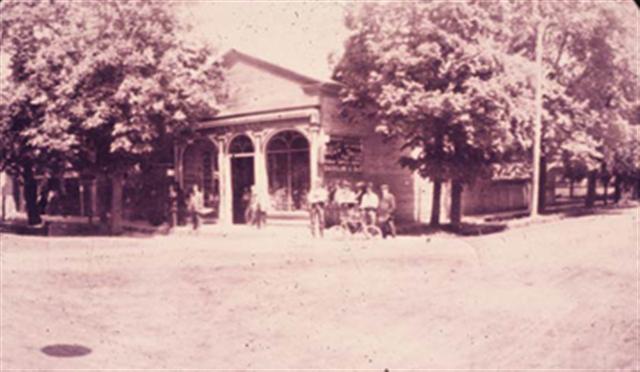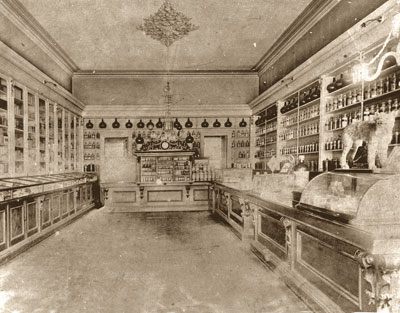|
The Randall Years
1898-1914
 
John deW. Randall
John Randall, Paffard's successor, left a major reputation for a wide range of civic contributions. Randall purchased the practice in 1898 from Paffard, with whom he had apprenticed before attending and graduating from the OCP School of Pharmacy in 1887 with a diploma, after a one-year programme. The option to earn a Bachelor of Pharmacy (Phm.B.) degree from the University of Toronto by taking an additional set of University exams did not appear until 1892, while the compulsory two-year Phm.B. graduates first appeared almost 40 years later in 1929, and the four-year B.Sc.Phm.'s in 1952. The U of T Faculty of Pharmacy is now poised to initiate an entry-level Doctor of Pharmacy programme, which hitherto has been a two-year full-time advanced professional degree following the four-year undergraduate pharmacy degree.
Most interesting perhaps, however, concerning Randall is the matter of his name as well as how he was perceived in his own time, at the time of his untimely death in 1914, as well as about 35 years later in 1948 when the local paper did a special feature about all the mayors in its history. First, the matter of his name. Although John Randall's family and first given name remained constant, the middle name went from "deWitt" to "deWolfe" and frequently just "deW." It certainly appears as "de Witt" in official documents and "deW." when space was at a premium in certain printed lists. However, "de Wolfe" is what appears on the elaborate stained-glass window at St. Marks's Anglican Church in town, as well as in a series about "Mayors of Niagara" in the Niagara Advance, of 4 November 1948—the latter written by J. E. Masters, someone who had worked with Randall in civic matters. It has been suggested that Randall didn't care for "deWitt" and opted for "de Wolfe," which may explain why his daughter chose that version for the stained-glass window, which was installed in 1952, some years after his sudden death in 1914.
The other interesting thing is the difference between the major glowing front-page story at the time of his death in 1914 as opposed to the sharp evaluation in the survey of mayors in that November issue of the Niagara Advance of 1948. Masters suggests that Randall had rather strong opinions about matters relating to the town and also believed in pushing projects to completion without delay. Thus he wasn't above over-riding the views of his own Town Council concerning Simcoe Park. Although he had been chosen Lord Mayor for 1907-1909 and part of 1912, he thereby forfeited re-election thereafter. While it would appear to have been commendable to be a man of action, his personal method of achieving results did not seem to be appreciated by other elected officials working with him. However, he was chosen Chief Magistrate in 1913.
Randall capitalized on the steam train, started in 1854 between Fort Erie and Niagara, as well as the electric trams that had run to St. Catharines from 1913 onward, both of which ran past the pharmacy on King Street. The train also connected with steamship service from Toronto. A sign outside Randall's advertised tickets for sale in the pharmacy (see pages 16 and 22), for which the dispensing counter had been extended to sell those tickets. For that consideration, both Randall and his family merited passes for both means of transport, which are displayed as part of one of the exhibits in the museum. However, at the time of the restoration in 1971 of the building to its original state of 1869, that extension and other changes during the intervening century were reversed.
Randall took ill unexpectedly in the pharmacy on Monday, 12 March 1914, went home early, and after what was described as "paralysis of the brain" [a stroke?], he died at 4:30 p.m. on Tuesday afternoon. Consequently, the common story that he died suddenly in the pharmacy appears to be apocryphal at best.
The Times of Niagara-on-the Lake on Friday of the same week devoted an entire column on its front page to the story of his last days, the funeral cortege of Masonic Lodge members from the Randall home to St. Mark's, the service, and interment in the Church cemetery on Thursday. Randall's funeral appeared to prompt flags at half mast in the whole town on public buildings and private homes, and a capacity crowd in the Church. There had been a special train for members of the Masonic Lodge from Niagara Falls, as well as a large contingent from St. Catharines and locally, since Randall had achieved such a high level of participation in the organization. He was also president of the Liberal Association of Niagara.
Randall's reputation for getting things done appears to have earned him both personal support, but also some local opposition. The matter of Simcoe Park, already referred to, as well as his plan to pave Queen street, which he pushed, for instance, lost him the mayoralty, although he did succeed in having cement walks installed before that happened.

It is also from Randall’s period of operation that we have the first photographs of both the exterior (above) and interior (below) of the pharmacy. The interior view of about 1900 to 1910, seen below, was particularly important, as previously mentioned, in determining the placement by the curator in the restoration of those early James Harvey, Jr., containers.

The exterior view of about the same time is equally interesting by showing the signage on the side of the pharmacy facing King Street, which identifies the operation as “Randall’s Drug Store.” It also advertises for sale: “Tobaccos, Post Cards, Kodak Supplies [i.e. cameras, film, etc.], Candies, Sundries, Gasoline & Oils” The gasoline and oil was for the relatively new “horseless buggies” or automobiles, that are first captured a short time later in photos from the Coyne period. Marine supplies may also have been implied. The photo, which may have been intended for postcards also shows a few local pedestrians in front of the pharmacy, as well as a group of “drugstore cowboys” on their bikes at the corner being captured for posterity. The cement sidewalk appears to be in place, but neither Queen nor King streets seem to have been paved yet; it made it a very dusty corner at times, which apparently prompted early removal of the crystal drops of the gasoliers/chandeliers, as the previous interior view confirms.
 
|


